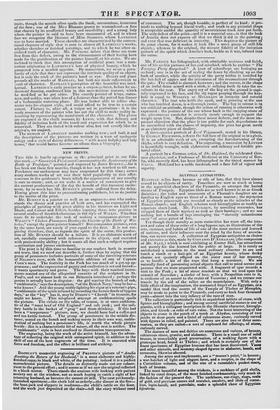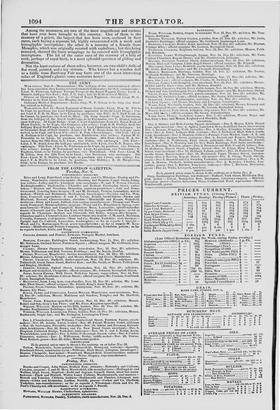EGYPTIAN ANTIQUITIES.
EGYPTIAN relics have become so rife of late, that they have almost ceased to be objects of rarity. Travellers arc now as much at home in the sepulchral chambers of the Pyramids, as amongst the buried streets of Pompeii. Egyptian idols are as well known to us as Greek divinities ; the toilet and ornaments of a Pharoah's daughter are as familiar to English eyes as those of a Roman matron ; the mysteries of Egyptian priesteraft are revealed as clearly as the miracles of the Roman church ; and English scholars read hieroglyphics as readily as reporters short-hand. Mr. PLTLIGRLW, by unrolling mummies, has stripped them of their mystery as well as their bandages; and we see nothing but a bundle of rags ens-eloping the "slovenly unhandsome corse" of sonic priest of Isis. Yet though their novelty as mere curiosities has worn off, the inte- rest and value of these relics of a long bygone age, as illustrations of the arts, customs, and habits of life of one of the most ancient and learned of nations, and their influence over the mind by the force of associa- tion, can never cease. A collection of Egyptian antiquities so choice and extensive as this, made by Giovasall D'Arnataasr, (the companion of Mr. SALT,) which is now exhibiting at Exeter Hall, has attractions not merely for the learned but the public at large. It is surely as satisfactory a sensation to the most ordinary observer to see and touch a comb or a hair-pin of an Egyptian beauty, whose dusky charms are quaintly effigied on the outer case of her mummy, as to handle a bit of the rope that hung a murderer. We are naturally fond of possessing actual objects that call to mind scenes and persons that we were acquainted with. A fragment of spar records a visit to the Peak ; a bit of stone reminds us that we trod upon the summit of Snowdon; a cinder of lava, with a Neapolitan coin in it, is evidence of an ascent to the crater of Vesuvius ; and we retrace our travels by the aid of the relics on the mantelpiece. With only a little effort of the imagination, the mumrnied finger of an Egyptian, Lira sandal that trod the courts of the Temple of Thebes or Memphis, may be made to point to tile Pyramids, and carry us back four thousand years—almost into the very infancy of the race of man.
The collection is particularly rich in sepulchral tablets of stone, with figures and hieroglyphics ; and among several sacrificial stones is one of granite, with a trilinguar inscription in the Hieratic character, hierogly- phics, and Greek--a relic of rare value. Not the least interesting of the objects in stone is the porch of a tomb at Abydos, consisting of two jambs or door-posts and a lintel of calcareous stone, curiously carved with figures in relief, and painted. There are also two or three sanc- tuaries, as they are called—a sort of cupboard for offerings, of stone, curiously carved. The statues of men and deities are numerous and various, of bronze, calcareous stone, granite, and alabaster. There is a small one of solid bronze, in remarkably good preservation, of a walking figure with a grotesque head, found at Thebes ; and which is certainly one of the finest specimens of Egyptian bronzes that has been discovered. Vases and other utensils, and mummy-shaped figures in alabaster, basalt, and terracotta, likewise abound. Among the arms and implements, are a "mason's point," in bronze; a war-hatchet of light and elegant form, and a sceptre, in the shape of a Corinthian column, and of the size of a constable's pocket mace, both of bronze. The most beautiful among the trinkets, is a necklace of gold shells,
linked by coral drops, of the most finished workmanship, very much in the fashion of the present day. The necklaces, ear-rings, nngs, seals of gold, and precious stones and scarabei, amulets„ and idols of corn. e- llen, lapis-lazuli, and porcelain, make a splendid show of Egypuan bijouterie.
Among the mummies, are two of the most magnificent and curious that have ever been brought to this country. One of them is the mummy of a priest, the largest that has been seen, enclosed in four cases, each having a separate lid, highly ornamented with a mask and hieroglyphic inscriptions : the other is a mummy of a female from Memphis, which was originally covered with asphaltum ; but this being removed, showed the linen wrappings to be covered with hieroglyphic inscriptions. The lid of the outer case of the mummy of a lady of rank, perhaps of royal birth, is a most splendid specimen of gilding and decoration.
Not the least curious of these relies, however, are two child's dolls of fiat wood, painted, and a toy sistrum. Who knows but a wooden doll or a fiddle from Bartlemy Fair may form one of the most interesting relics of England's glories some centuries hence !



























 Previous page
Previous page